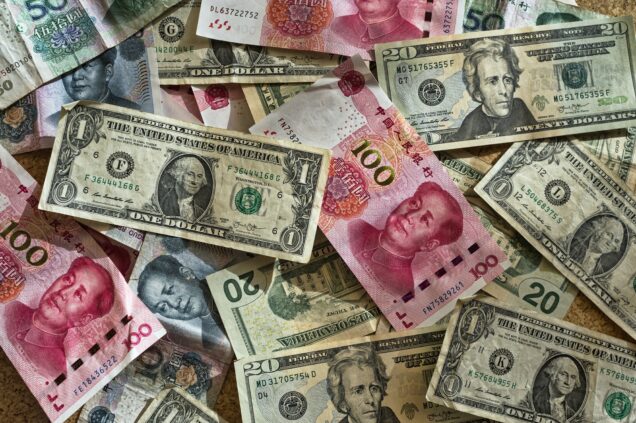Op-Ed: The Dawn of a New Cold War: Globalization of the U.S.-China Rivalry

By Emma Liu
Great power competition is back. In the Indo-Pacific and around the globe, the United States (U.S.) and China have entered a new stage of their rivalry that can only be aptly dubbed a “New Cold War.” Despite the mounting criticism from scholars and repetitive denials from policymakers, geopolitical and strategic reality will soon render the terminological debate pointless. Indeed, the tide of U.S.-China competition has inundated geopolitical, economic, and strategic domains across continents, causing the world to reckon with where the path leads forward. The rivalry between the two great powers will be inevitably internecine with numerous secondary states playing a critical role in the coming episodes.
For China, the primary source of its national power is its formidable economic prowess. Thanks to a series of “reform and opening” policies adopted since 1978, China’s national economy has witnessed meteoric growth with an average 10 percent GDP growth rate for almost twenty years. Through the deepening of reforms regarding the fiscal, tax, and financial systems, restructuring of state-owned enterprises (SOEs), and opening to international trade, China, as the top trading partner to more than 120 countries, has considerably integrated into the global economic system and exerted significant influence in international affairs. The launch of the Belt and Road Initiative (BRI) in 2013 has further deepened the economic interdependence between China and the host countries and magnified China’s international influence.
To be sure, China’s unprecedented economic growth does not automatically lock the country in an inevitable war with the US, be it either military or through economics. Another condition is needed to trigger this gloomy outcome. Aside from its growing national strength, the rising power must become so unsatisfied with the existing international order that reforming or replacing the old order with a new one, established by the rising power itself, will appear to be the only viable solution for its survival and critical national interests. Otherwise, the Thucydides Trap might be circumvented. For this reason, many argue that there has been no reason for China to have dissatisfaction with the current international order from which the country has immensely benefited, especially after its accession to the World Trade Organization primarily facilitated by the U.S. In contrast, it is in Beijing’s best interest to help sustain the existing international order instead of subverting it.
Unfortunately, that was not the case. Since the 2008 global financial crisis, where China’s successful response contributed substantially to global economic and financial stability and recovery, Beijing has begun to believe its own propaganda that the “Chinese model” of governance and economic development was superior to its Western counterparts and started to derail from its “peaceful rise.” In 2013, Xi Jinping announced the Major Country Diplomacy doctrine “with Chinese characteristics,” replacing Deng Xiaoping’s “low profile” principle, as the guiding doctrine for China’s foreign policy in the new era. This doctrine justifies China’s actions to assume a more assertive role in world affairs to the extent that China perceived as proper to its great power status. Along with the constant practice of the “wolf warrior diplomacy” and military buildup, most recently, Beijing has announced three new initiatives–Global Security Initiative (GSI), Global Development Initiative (GDI), and Global Civilization Initiative (GCI)–as well as an ambitious proposal on the reform and development of global governance, attempting to reshape the international system.
Against the broader backdrop of the U.S.-China rivalry, many secondary states in the region will be forced, intentionally or unintentionally, to take sides regardless of their preference for the opposite. Nevertheless, they can also play a vital role in deciding the balance of the game.
Beijing’s sharp turn in its foreign policy from the “peaceful development” under the Hu Jintao administration to the “great rejuvenation of the Chinese nation” manifested in the nationalist China Dream under Xi Jinping alerted many secondary states of the nature of China’s rise. Newly gained economic muscle combined with an assertive foreign policy agenda has made China’s behaviors increasingly aggressive toward its neighbors over disputed territory along its border and in the South and East China Seas. The heightened tension has pushed some of those countries (e.g., India and the Philippines) to shift away from traditional “soft-balancing” to a more “hard-balancing” position. Hence, one of the biggest challenges for China to leverage its economic strength in the U.S.-China competition is how to better manage its relationships with its immediate neighbors.
For the US, the greatest asset it possesses vis-a-vis China is its intricate system of alliances and partnerships with secondary states. Most of the U.S. allies and partnerships are democracies with an advanced capitalist economy. This has lent the U.S. huge leverage in countering China politically, economically, and strategically. For example, in the Asia-Pacific, the alliances and partnerships with Japan, South Korea, Australia, India, and the ASEAN countries have enabled the U.S. to isolate China in the region. Japan’s recently announced export ban on twenty-three types of advanced semiconductor manufacturing equipment and a potential U.S.-Dutch-Japanese semiconductor export control deal will take a heavy toll on China’s high-tech industry. Globally, alliances and partnerships enabled the U.S. to rally them around the cause to counter an aggressive authoritarian China that is, from the U.S. perspective, trying to overthrow the existing international rule-based order and defeat democracy.
Nevertheless, like China, the US also has serious shortcomings in its strategic competition with China. The most critical is its perceived lack of commitment in the economic arena. Given the fact that many secondary states, especially those in the Global South, share both the dire need to develop essential infrastructure and national economy and the general incapability to reform, China’s financial offer in its “coordinated credit space model” is much more attractive than those of the IMF. Furthermore, China has been actively involved in many regional economic frameworks and institution-building, such as RCEP, AIIB, CPTPP, and the unprecedented BRI, while the efforts of the U.S. have mainly stagnated. How much and what effect the U.S.-led Indo-Pacific Economic Framework for Prosperity (IPEF) will bring about remains too early to tell. If the U.S. wishes to shore up its position in competing with China, it must substantially enhance its economic commitment to secondary states.
Another important issue of which the U.S. should take note is the diverse concerns of its allies and partners entangled in the U.S.-China competition. Most of the secondary states do not like to be forced to pick sides between the two great powers. “Hedging” is a proper word to describe their general position. The ASEAN countries are a case in point. They wish to continue to benefit from economic interactions with China while ensuring their national security through close ties with the U.S. Another example is India. Despite being a Quad member, New Delhi has been cautious about its position on Taiwan and Russia’s war in Ukraine due to its economic concerns with Beijing and Moscow. Even the U.S.’ closest allies in Europe (such as France and Germany) are not fully in line with the U.S. position confronting China. “De-risking not decoupling,” the EU claimed, is the way to go. Taking into account the allies’ and partners’ legitimate concerns, the U.S. should downplay its rhetorical line of “democracy vs. authoritarianism” while giving priority to economic and strategic cooperation with the secondary states.
A full-fledged U.S.-China rivalry is in place and will likely continue in the foreseeable future, where more conflicts are to come. Yet, neither the U.S. nor China has sufficient power to defeat the other without deadly injuring itself. How to minimize the damages of those conflicts while sustaining the base for future cooperation in the wake of this challenging era is a serious task for the younger generation in every state.

Bibliography
Abrams, Elliott. “The New Cold War.” Council on Foreign Relations. March 4, 2022. https://www.cfr.org/blog/new-cold-war-0.
Allen, Gregory C., et al. “Japan and the Netherland Announce Plans for New Export Controls on Semiconductor Equipment.” CSIS. April 10, 2023. https://www.csis.org/analysis/japan-and-netherlands-announce-plans-new-export-controls-semiconductor-equipment.
Chair’s Statement of the High-Level Dialogue on Global Development. Ministry of Foreign Affairs of the People’s Republic of China. June 24, 2022. https://www.fmprc.gov.cn/mfa_eng/zxxx_662805/202206/t20220624_10709812.html.
Cheng-Chwee, Kuik. “Southeast Asia Hedges Between Feasibility and Desirability.” East Asia Forum. July 04, 2023. https://www.eastasiaforum.org/2023/07/04/southeast-asia-hedges-between-feasibility-and-desirability/.
Chin, Gregory T. and Kevin P. Gallagher. “Coordinated Credit Spaces: The Globalization of Chinese Development Finance.” Development and Change 50, no.1 (January 2019): 245-274. https://doi.org/10.1111/dech.12470.
“Fact Sheet: In Asia, President Biden and a Dozen Indo-Pacific Partners Launch the Indo-Pacific Economic Framework for Prosperity.” The White House Briefing Room. May 23, 2022. https://www.whitehouse.gov/briefing-room/statements-releases/2022/05/23/fact-sheet-in-asia-president-biden-and-a-dozen-indo-pacific-partners-launch-the-indo-pacific-economic-framework-for-prosperity/.
“GDP Growth (Annual %) – China.” The World Bank. https://data.worldbank.org/indicator/NY.GDP.MKTP.KD.ZG?locations=CN.
Gewirtz, Paul. “Words and Policies: ‘De-risking’ and China Policy.” Brookings. May 30, 2023. https://www.brookings.edu/blog/order-from-chaos/2023/05/30/words-and-policies-de-risking-and-china-policy/
Glaser, Bonnie S, and Evan S Medeiros. “The Changing Ecology of Foreign Policy-Making in China: The Ascension and Demise of the Theory of ‘Peaceful Rise.’” The China Quarterly 190 (2007): 291-310. doi:10.1017/S0305741007001208.
Green, Mark A. “China is the Top Trading Partner to More Than 120 Countries,” Wilson Center. January 17, 2023. https://www.wilsoncenter.org/blog-post/china-top-trading-partner-more-120-countries#:~:text=China%20is%20the%20top%20trading%20partner%20to%20more%20than%20120%20countries.
Heath. Timothy R. “Xi’s Cautious Inching Towards the China Dream.” Rand Corporation. August 11, 2023. https://www.rand.org/pubs/external_publications/EP70200.html.
Levy, Jack S. “Power Transition Theory and the Rise of China.”
Menon, Shivshandar. “Taiwan: An India View.” Brookings. December 16, 2022, https://www.brookings.edu/blog/order-from-chaos/2022/12/16/taiwan-an-indian-view/.
Paul, T.V. “Rising China and Soft Balancing,” in Restraining Great Powers: Soft Balancing from Empires to the Global Era. New Haven, CT: Yale University Press.
Proposal of the People’s Republic of China on the Reform and Development of Global Governance. Ministry of Foreign Affairs of the People’s Republic of China. September 13, 2023. https://www.fmprc.gov.cn/eng/wjbxw/202309/t20230913_11142010.html.
Schuman, Michael, Jonathan Fulton, and Tuvia Gering. “How Beijing’s Newest Global Initiatives Seek to Remake the World Order.” Atlantic Council. June 21, 2023. https://www.atlanticcouncil.org/in-depth-research-reports/issue-brief/how-beijings-newest-global-initiatives-seek-to-remake-the-world-order/.
Smith, Sheila A. “The Quad in the Indo-Pacific: What to Know.” Council on Foreign Relations. May 27, 2021. https://www.cfr.org/in-brief/quad-indo-pacific-what-know.
The Global Security Initiative Concept Paper. Ministry of Foreign Affairs of the People’s Republic of China. February 21, 2023. https://www.fmprc.gov.cn/mfa_eng/wjbxw/202302/t20230221_11028348.html.
Wang, Yi. “Exploring the Path of Major-Country Diplomacy with Chinese Characteristics.” Ministry of Foreign Affairs of the People’s Republic of China. June 27, 2013. https://www.fmprc.gov.cn/mfa_eng/wjb_663304/wjbz_663308/2461_663310/201306/t20130627_468425.html.